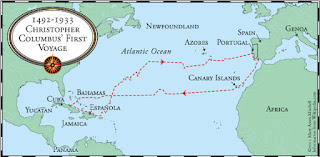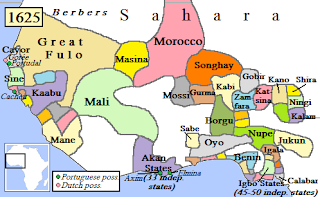The aftermath of the abolishing of slave trade in africa
In 1787, the British helped 400 freed slaves, primarily African Americans freed during the
 American Revolutionary War, West Indians and Africans from London, to relocate to Sierra Leone to settle in what they called the "Province of Freedom." Some had been freed earlier and worked as servants in London.
American Revolutionary War, West Indians and Africans from London, to relocate to Sierra Leone to settle in what they called the "Province of Freedom." Some had been freed earlier and worked as servants in London.
Most of the first group died due to disease and warfare with indigenous peoples. About 64 survived to settle Granville Town. In 1792, they were joined by 1200 Black Loya
After Britain and the United States abolished the international African slave trade beginning in 1808, they patrolled off the continent to intercept illegal shipping. The British resettled
Emancipated Africansat Freetown.
lists from Nova Scotia, African Americans and their descendants; some adults had left rebel owners and fought for the British in the revolutionary War. The Crown freed them as promised and resettled 3,000 of the African Americans  American Revolutionary War, West Indians and Africans from London, to relocate to Sierra Leone to settle in what they called the "Province of Freedom." Some had been freed earlier and worked as servants in London.
American Revolutionary War, West Indians and Africans from London, to relocate to Sierra Leone to settle in what they called the "Province of Freedom." Some had been freed earlier and worked as servants in London.Most of the first group died due to disease and warfare with indigenous peoples. About 64 survived to settle Granville Town. In 1792, they were joined by 1200 Black Loya
After Britain and the United States abolished the international African slave trade beginning in 1808, they patrolled off the continent to intercept illegal shipping. The British resettled
Emancipated Africans
The Liberated Africans included people from the Yoruba, Igbo, Efik, Fante, and other ethnicities of West Africa.
Some members of Temne, Limba, Mende, and Loko groups, indigenous Sierra Leone ethnicities, were also among the Liberated Africans resettledat
The black poor(
The first settlers to found a colony in Sierra Leone were the so-called "Black Poor": African Americans and West Indians. 411 settlers arrived in May 1787. Some were Black Loyalists who were either evacuated or travelled to England to petition for a land of their own; Black Loyalists had joined British colonial forces during the American Revolutionary War ,
enslavement
Many died on the journey fromEngland but .
Although initially there was no hostility between the two groups, after King Tom's death the next Temne chief retaliated for a slave trader's burning his village. He threatened to destroy Granville Town. The Temne ransacked Granville Town and took some Black Poor into slavery, while others became slave traders .
The Nova Scotians and the Freetown Colony 1792–1799
 The proponents and directors of the Sierra Leone colony believed that a new colony did not need black settlers from London. The directors decided to offer resettlement to African Americans from Nova Scotia, despite the failure of the last colony. These settlers were Black Loyalists, American slaves who had escaped to British lines and fought with them during the American Revolution, to earn freedom. The British had transported more than 3,000
The proponents and directors of the Sierra Leone colony believed that a new colony did not need black settlers from London. The directors decided to offer resettlement to African Americans from Nova Scotia, despite the failure of the last colony. These settlers were Black Loyalists, American slaves who had escaped to British lines and fought with them during the American Revolution, to earn freedom. The British had transported more than 3,000 freedmen As much Sierra Leone they
Maroons and other transatlantic immigrants
Main article: Jamaican Maroons in Sierra Leone
The next arrivals were the Jamaican Maroons ;  Town, one of the five Maroon cities in Jamaica. These runaway ex-slaves numbered around 551, and they helped quell some of the riots against the British from the Settlers. The Maroons later fought against the Temne during the Temne Attack of 1801. [10]
Town, one of the five Maroon cities in Jamaica. These runaway ex-slaves numbered around 551, and they helped quell some of the riots against the British from the Settlers. The Maroons later fought against the Temne during the Temne Attack of 1801. [10]
The next migrations were smaller. West Indian soldiers from the 2nd and 4th West India Regiments settled in Freetown and in suburbs around it. Thirty-eight African Americans (consisting of nine families) immigrated to Freetown under the auspices of Paul Cuffe of Boston. Black Americansimmigrating
Recaptives
Main article: Sierra Leone Liberated Africans
An 1835 illustration of liberated slaves arriving in Sierra Leone.
The last and major group of immigrants to the colonywere , , Krios their : Recaptive would ,
Some members of Temne, Limba, Mende, and Loko groups, indigenous Sierra Leone ethnicities, were also among the Liberated Africans resettled
The black poor
The first settlers to found a colony in Sierra Leone were the so-called "Black Poor": African Americans and West Indians. 411 settlers arrived in May 1787. Some were Black Loyalists who were either evacuated or travelled to England to petition for a land of their own; Black Loyalists had joined British colonial forces during the American Revolutionary War
Many died on the journey from
Although initially there was no hostility between the two groups, after King Tom's death the next Temne chief retaliated for a slave trader's burning his village. He threatened to destroy Granville Town. The Temne ransacked Granville Town and took some Black Poor into slavery, while others became slave traders
The Nova Scotians and the Freetown Colony 1792–1799
 The proponents and directors of the Sierra Leone colony believed that a new colony did not need black settlers from London. The directors decided to offer resettlement to African Americans from Nova Scotia, despite the failure of the last colony. These settlers were Black Loyalists, American slaves who had escaped to British lines and fought with them during the American Revolution, to earn freedom. The British had transported more than 3,000
The proponents and directors of the Sierra Leone colony believed that a new colony did not need black settlers from London. The directors decided to offer resettlement to African Americans from Nova Scotia, despite the failure of the last colony. These settlers were Black Loyalists, American slaves who had escaped to British lines and fought with them during the American Revolution, to earn freedom. The British had transported more than 3,000 Maroons and other transatlantic immigrants
Main article: Jamaican Maroons in Sierra Leone
The next arrivals were the Jamaican Maroons
 Town, one of the five Maroon cities in Jamaica. These runaway ex-slaves numbered around 551, and they helped quell some of the riots against the British from the Settlers. The Maroons later fought against the Temne during the Temne Attack of 1801. [10]
Town, one of the five Maroon cities in Jamaica. These runaway ex-slaves numbered around 551, and they helped quell some of the riots against the British from the Settlers. The Maroons later fought against the Temne during the Temne Attack of 1801. [10]The next migrations were smaller. West Indian soldiers from the 2nd and 4th West India Regiments settled in Freetown and in suburbs around it. Thirty-eight African Americans (consisting of nine families) immigrated to Freetown under the auspices of Paul Cuffe of Boston. Black Americans
Main article: Sierra Leone Liberated Africans
An 1835 illustration of liberated slaves arriving in Sierra Leone.
The last and major group of immigrants to the colony




Comments
Post a Comment